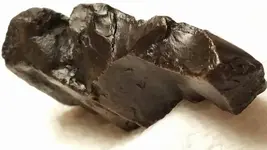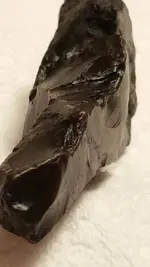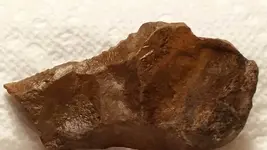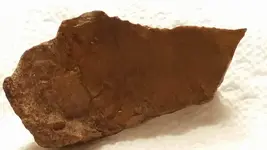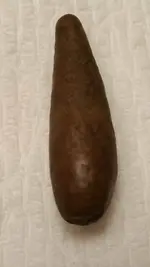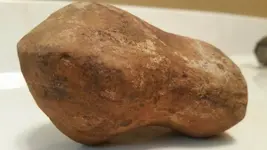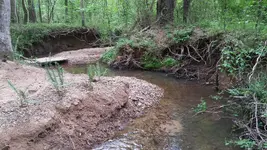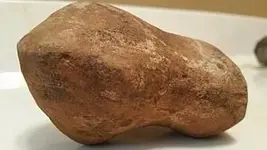Thank you Charl I will check out the link you recommended. Learning links are very helpful! I agree, teaching someone on a forum is no comparison to having a person right there to share their thinking and answer questions. It may be forum accurate to say "we just know", but as a teacher, as well as a teacher of teachers, I've spent a career teaching students and educators to seek understanding of "why". It's a natural stone because..., that is from creek tumbling because..., etc. I think that if I post a pic of something that does not show work, perhaps someone would have a pic of something that does show work and could explain what they notice as far as the differences.
This response from Get-the-point was very helpful in helping me understand what omars are and what you would notice in a stone that is not an omar: "It is natural. A circular pattern would be at the hole if it was used as a firestarter. It shows no.evidence of pecking to form. A sharpening stone would show striation marks indicating back and forth motion. ......you can look at Omar's or rocks with holes and you will see countless identical examples.............".
I really do appreciate you taking the time to look at my pics and share your thinking on them. Thanks Charl!
Well, this is why I said it is not 100% impossible to teach a beginner something in a forum format. I'm sure Chris did a good job describing what an Omar is. But that's not hard to do. I was a teacher for a spell. Even got a degree in geology. But I taught History. But not without a lesson plan. Most of us here, myself included, are not teachers of how to distinguish rock from artifact. Most of us learned that through experience, and don't even remember the steps we may have had to go through in our minds to learn the distinction. To get to the point where recognizing when a rock was just a rock became second nature. In a way, you're still talking as if you think it must all be as easy as describing to someone what an Omar is. But it's often not that easy at all. Especially when we are not ourselves teachers of a subject that we no longer have to think through. Surely you understand how difficult it is to teach what has become second nature, and what may have become second nature knowledge decades ago?
In your original thread by this title, another poster told you early on to take anything said to you here with a grain of salt, because folks don't enlarge the photos. He was upset that people did not recognize he had artifacts showing amidst many ordinary rocks. Yet, if he knew they were artifacts, why was he grouping them with the non artifacts and asking if they were artifacts, if he already knew they were artifacts? IMO, that poster painted a broad stroke of this forum that was unfair. The novice bears some responsibility for teaching themselves. As in immersing themselves in real artifacts up the yin yang so as to know what they look like.
Another thing that should be kept in mind is that beginners with rocks don't show up once in a blue moon. It happens multiple times a week. Hence the inclination to make it short and sweet: "that's just a rock". And when the beginner says "why?", and we are not by profession teachers of the art of distinguishing rocks not altered by man from rocks altered by man, how do we go about teaching the difference? You may be expecting the kind of teachers that we collectors are not. Not everything, like an Omar, is simple to explain. And, because this happens multiple times a week, it is simply asking too much, IMHO, to expect there will always be detailed replies beginning "that's just a rock because...." You may be expecting too much patience on our part, as well as expecting everything is as easy to explain as an Omar. You ask for teachers, but is it fair to expect these teaching lessons upteen times, every single time a beginner shows up? I think it is expecting too much. If a beginner is told "visit and view as many collections of genuine artifacts as you possibly can", it puts the responsibility on the beginner. We will help as we are able, but the beginner has a responsibility to help themselves. Complaining that one should take what is said here with a grain of salt, as that one poster did, is a low opinion of the forum, and is absolving oneself of some responsibility to learn from many venues, not just an Internet forum.
If I had to teach the lessons you expect, multiple times a week on a forum, whether this one or others, would I? Would you? Over and over and over again?? Personally, I think it is asking a lot. Chris had an advantage. Explaining an Omar is not so hard. In general, it's not at all as easy as some expect it should be. Especially when one is asked to do so again and again and again....
I can give you some advice. Learn what flaked artifacts look like. Visit museums, view collections whenever you can find them, online, or in person. And leave rocks that are not flaked in the stream where you find them. Stop collecting them altogether. Start with learning to recognize flaked artifacts. The second of the first two pieces you showed us here, the same ones from the original thread, looks like it might be a worked flake tool. Leave the big smooth rocks be until you've learned to recognize what 99.9% of the artifacts you find will always be: flaked stone tools. Learn those first. You may find large ground stone tools someday, but it will always be a rare event. Start with flaked artifacts. The two pieces that began the original thread show you are on the right track in that respect. Stick with it, and for now, unless they are screaming "I am a full groove axe, collect me!!!", leave 'em be and stick to rocks that seem to show flaking. And, as I said, that second one might be a retouched flake, a flake blade, it may be artifactual!



